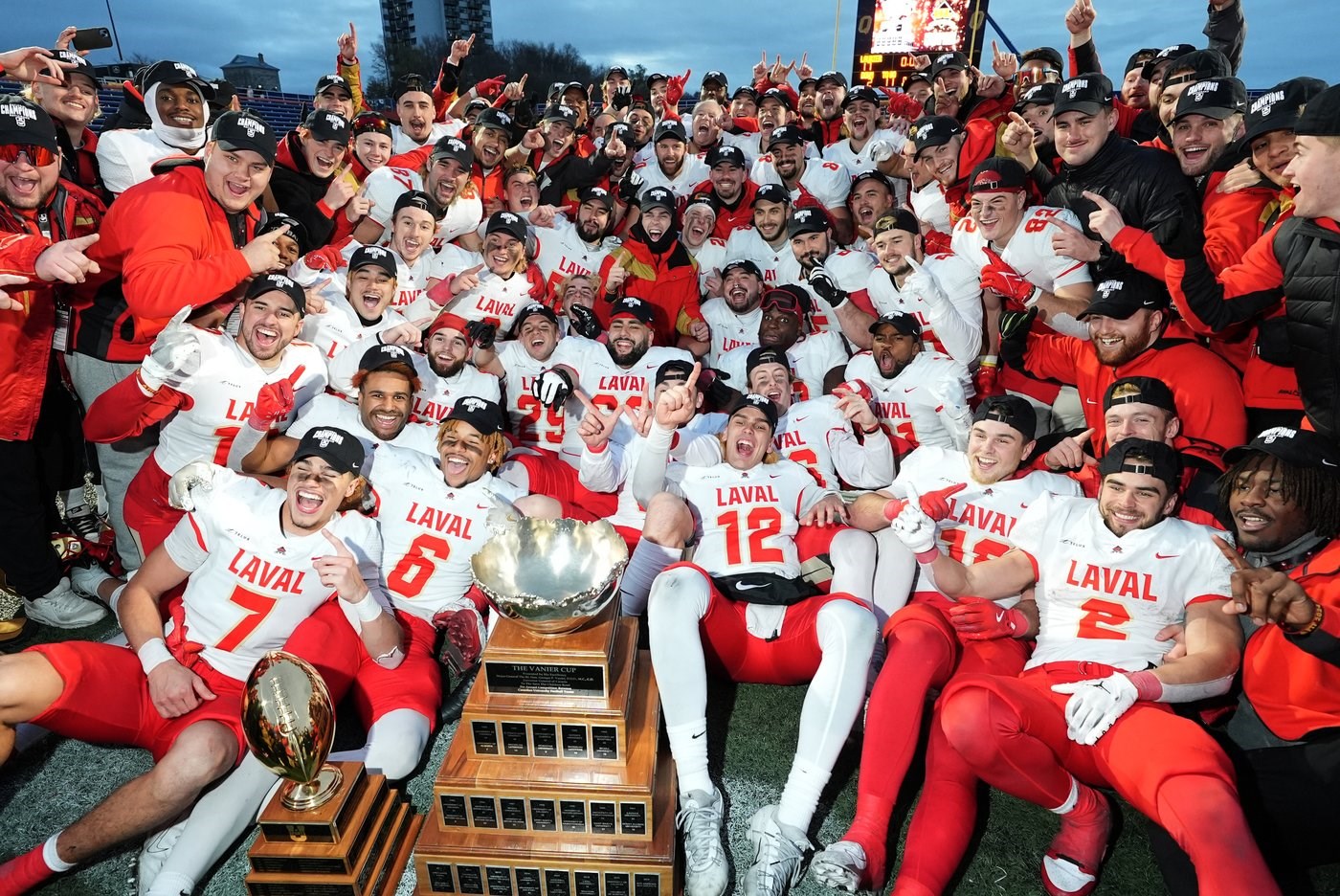
Laval University Rouge et Or players pose for photos with the trophy as they celebrate their win over Laurier Golden Hawks after U Sports Vanier Cup football action in Kingston, Ontario on Saturday, Nov. 23, 2024. THE CANADIAN PRESS/Frank Gunn
September 23, 2025 - 12:09 PM
U Sports chief executive officer Pierre Arsenault says Canadian universities have the luxury of time to decide how they'll tackle impending change in the country's football landscape.
On Monday, CFL commissioner Stewart Johnston unveiled significant changes it will make over the next two years. In 2026, the league will eliminate single points from missed field goals, punts and kickoffs that clear the end zone -- either through the air or on a bounce -- while instituting a 35-second playclock and having teams' benches on either side of the field at all venues.
But the most significant changes come in 2027, when the CFL will modify its fields. They'll be reduced from 110 yards to 100 yards, end zones will go from 20 yards to 15 yard and goalposts will be moved from the goal-line to the back of the reconfigured end zones.
Arsenault said U Sports officials were apprised of the CFL's intentions Monday before Johnston's afternoon news conference at a Toronto hotel. He understands the CFL doing what it must to enhance its product but added Canadian universities will take their time to gather facts before discussing the future.
"We want to make sure in the time since the announcement that we communicate with member schools and conferences and just set the direction where we'll all talk about this," Arsenault said Tuesday. "We'll look at all of the vantage points for what's the direction that makes sense.
"When you talk about the infrastructure, it could be really expensive certainly for the university system and then municipal and school board-run fields across the country. I think then it becomes a question of what's possible over what time span?"
Arsenault had no issue with U Sports not being involved directly in the CFL's discussion.
"We respect the fact it's a complex matter to discuss changes of this magnitude and they took the approach they felt they had to and that made sense," he said. "Now we're on the other side of it with the information being out there and we'll do the same."
It's estimated the cost to reconfigure a Canadian field to 100 yards with 15-yard end zones could be between $800,000 to $1-million per school. And that would be at a time when many Canadian universities are facing financial challenges.
Many artificial turfs have a lifespan of roughly 10 years and so schools budget accordingly. For those institutions that have recently installed a new field, the idea of having to pay for reconfiguration could result in the decision to keep playing on the surface until the time it was budgeted for replacement.
And if a field has numbers and lines stitched into it, there's the real possibility of having to purchase a new playing surface.
"It's premature to project what our system is going to decide about what field we'll use," Arsenault said. "Ultimately, that part aside, you'd think we're heading into a phase here that could be a number of years, it could be prolonged where both types of fields exist at the university and amateur levels.
"I think what might be a good starting point is the fundamental question, 'Is it going to be OK for leagues to play games that are on either field format?'
Like U Sports, Football Canada will thoroughly review the CFL's changes before deciding the path it will follow.
"Together with our leadership and partners, we will evaluate these changes and thoroughly address their potential affect the amateur football ecosystem within Canada," it said in a statement.
U Sports is annually a major provider of football talent to the CFL, something Arsenault said is a source of pride for Canadian schools. However, universities haven't always adopted the same changes the CFL has -- including the size of footballs used, where converts are kicked from and field hash marks.
"So there are differences now," he said. "Ultimately we're very proud of the connection and number of U Sports players that jump to the CFL.
"We want to make sure that pathway and those avenues are still there for our student-athletes."
This summer, Laurier quarterback Taylor Elgersma, signed as an undrafted free agent with the NFL's Green Bay Packers. The 2024 Hec Crighton Trophy winner as Canadian university's top player performed well in training camp and exhibition games before being among the team's final cuts.
"If you look at Taylor Elgersma's story, he showed he can hang with any NFL player," Arsenault said. "The differences in the games weren't a barrier."
This report by The Canadian Press was first published Sept. 23, 2025.
News from © The Canadian Press, 2025